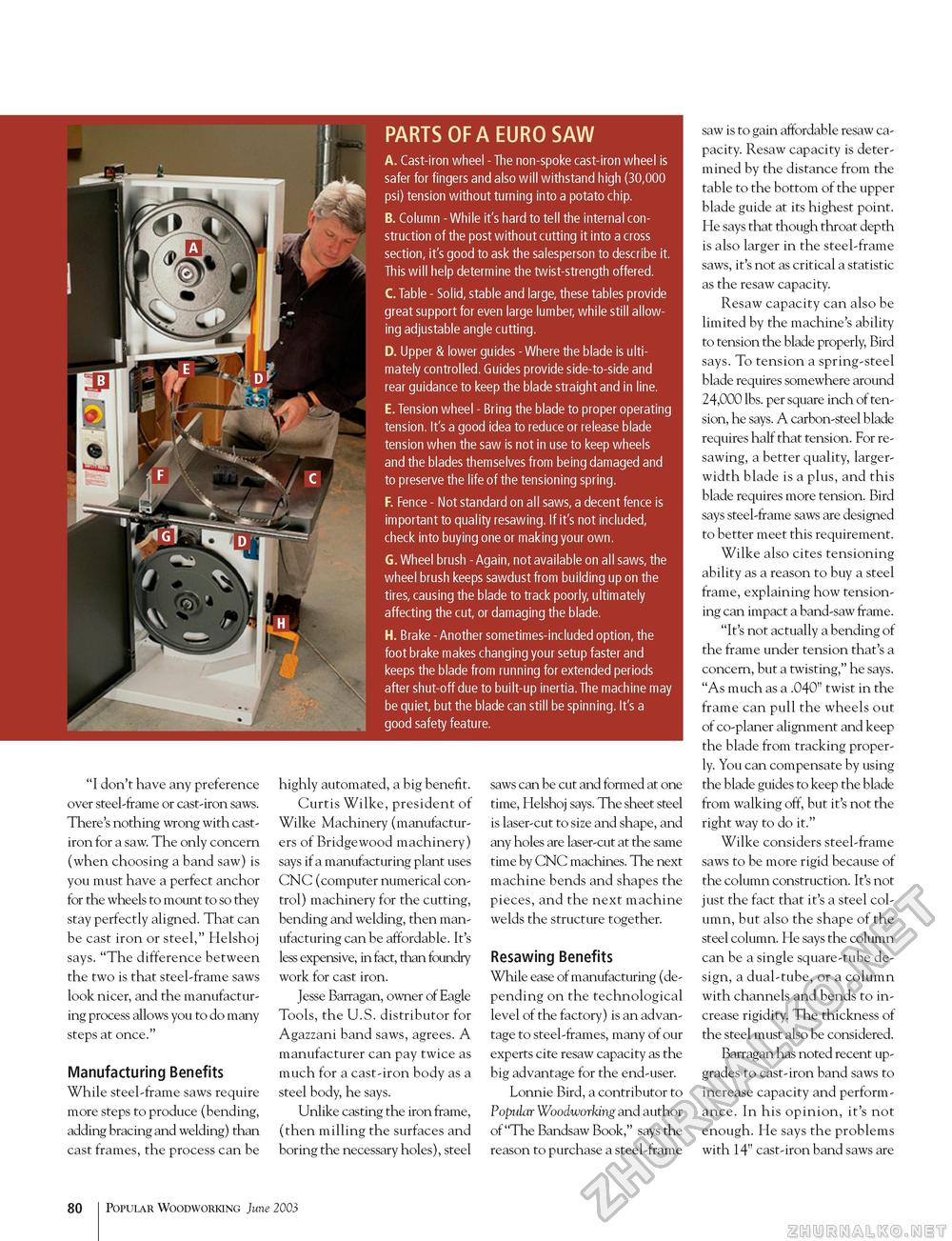Popular Woodworking 2003-06 № 134, страница 82
A. Cast-iron wheel - The non-spoke cast-iron wheel is safer for fingers and also will withstand high (30,000 psi) tension without turning into a potato chip. B. Column - While it's hard to tell the internal construction of the post without cutting it into a cross section, it's good to ask the salesperson to describe it. This will help determine the twist-strength offered. C. Table - Solid, stable and large, these tables provide great support for even large lumber, while still allowing adjustable angle cutting. D. Upper & lower guides - Where the blade is ultimately controlled. Guides provide side-to-side and rear guidance to keep the blade straight and in line. E. Tension wheel - Bring the blade to proper operating tension. It's a good idea to reduce or release blade tension when the saw is not in use to keep wheels and the blades themselves from being damaged and to preserve the life of the tensioning spring. F. Fence - Not standard on all saws, a decent fence is important to quality resawing. If it's not included, check into buying one or making your own. G. Wheel brush - Again, not available on all saws, the wheel brush keeps sawdust from building up on the tires, causing the blade to track poorly, ultimately affecting the cut, or damaging the blade. H. Brake - Another sometimes-included option, the foot brake makes changing your setup faster and keeps the blade from running for extended periods after shut-off due to built-up inertia.The machine may be quiet, but the blade can still be spinning. It's a good safety feature. "I don't have any preference over steel-frame or cast-iron saws. There's nothing wrong with cast-iron for a saw. The only concern (when choosing a band saw) is you must have a perfect anchor for the wheels to mount to so they stay perfectly aligned. That can be cast iron or steel," Helshoj says. "The difference between the two is that steel-frame saws look nicer, and the manufacturing process allows you to do many steps at once." Manufacturing Benefits While steel-frame saws require more steps to produce (bending, adding bracing and welding) than cast frames, the process can be highly automated, a big benefit. Curtis Wilke, president of Wilke Machinery (manufacturers of Bridgewood machinery) says if a manufacturing plant uses CNC (computer numerical control) machinery for the cutting, bending and welding, then manufacturing can be affordable. It's less expensive, in fact, than foundry work for cast iron. Jesse Barragan, owner of Eagle Tools, the U.S. distributor for Agazzani band saws, agrees. A manufacturer can pay twice as much for a cast-iron body as a steel body, he says. Unlike casting the iron frame, (then milling the surfaces and boring the necessary holes), steel saws can be cut and formed at one time, Helshoj says. The sheet steel is laser-cut to size and shape, and any holes are laser-cut at the same time by CNC machines. The next machine bends and shapes the pieces, and the next machine welds the structure together. Resawing Benefits While ease of manufacturing (depending on the technological level of the factory) is an advantage to steel-frames, many of our experts cite resaw capacity as the big advantage for the end-user. Lonnie Bird, a contributor to Popular Woodworking and author of "The Bandsaw Book," says the reason to purchase a steel-frame saw is to gain affordable resaw capacity. Resaw capacity is determined by the distance from the table to the bottom of the upper blade guide at its highest point. He says that though throat depth is also larger in the steel-frame saws, it's not as critical a statistic as the resaw capacity. Resaw capacity can also be limited by the machine's ability to tension the blade properly, Bird says. To tension a spring-steel blade requires somewhere around 24,000 lbs. per square inch of tension, he says. A carbon-steel blade requires half that tension. For resawing, a better quality, larger-width blade is a plus, and this blade requires more tension. Bird says steel-frame saws are designed to better meet this requirement. Wilke also cites tensioning ability as a reason to buy a steel frame, explaining how tension-ing can impact a band-saw frame. "It's not actually a bending of the frame under tension that's a concern, but a twisting," he says. "As much as a .040" twist in the frame can pull the wheels out of co-planer alignment and keep the blade from tracking properly. You can compensate by using the blade guides to keep the blade from walking off, but it's not the right way to do it." Wilke considers steel-frame saws to be more rigid because of the column construction. It's not just the fact that it's a steel column, but also the shape of the steel column. He says the column can be a single square-tube design, a dual-tube, or a column with channels and bends to increase rigidity. The thickness of the steel must also be considered. Barragan has noted recent upgrades to cast-iron band saws to increase capacity and performance. In his opinion, it's not enough. He says the problems with 14" cast-iron band saws are 80 Popular Woodworking June 2003 |








